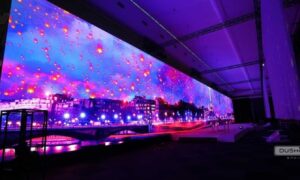Advertising is presented to the buyer in different formats: in the form of texts on websites, images, and videos. Most people are visuals, so they perceive the video format better. It is easier for clients to take in information at a glance, without bothering to read.
Touch screens can be used both outdoors and indoors. Monitors on which advertising is broadcast can be found in shopping centers, exhibition halls, and on the squares of large cities. This type of promotion is more expensive than others. The use of screens in an advertising campaign indicates the profitability and status of the brand. If you are considering 15-inch or 22-inch touchscreen monitors for promotional purposes, then this article is for you.
Types of advertising screens
Interactive screens differ in the place of installation and the method of transportation. According to the place of installation, the screens are divided into internal (indoor) and external (outdoor). According to the method of transportation, mobile and stationary are distinguished.
Advertising indoor screens
Indoor monitors are touch screens for exhibitions, banks, and government agencies. For example, monitors in children’s hospitals broadcast cartoons that entertain little patients. Touch screens are used for events in schools and museums.
An advertising stand with a built-in monitor is gaining popularity. A product is placed on it, and information about which is broadcast on the screen. So the buyer gets a complete picture of the company and the benefits of the product.
At sites with a large crowd of people, monitors are used not only for advertising purposes but also for conveying information. For example, a train station may broadcast a train schedule. The screen placed at the stadium will help to find out the score of the game or the opinion of the referees.
Advertising indoor-screens are designed for lower brightness due to indoor lighting. Indoors, the level of humidity and temperature is stable, so the operation of the monitor does not require adaptation to weather conditions. Also, fewer resources are spent on protection, because the monitor will not fall into the rain and will not suffer from the wind.
The cost of an interactive monitor depends on such characteristics of the advertising screen as resolution, brightness, degree of protection, and design complexity.
Outdoor interactive advertising
Outdoor screens are placed in places with good traffic, for example, in the city center. They can be found on the ends of buildings, facades, and billboards. Monitors with high resolution are often used at outdoor concerts and sporting events.
An advertising structure of a large area may consist of several monitors connected to a network. Each screen is a part of the whole image, broadcasting its own block of information. This approach helps achieve better image quality and variability. The fastening of screens requires a particularly strong metal construction.
LED screens
LED screens are used to broadcast video:
- in shopping centers;
- at stadiums and sports grounds;
- at exhibitions;
- at train stations and metro stations;
- in exhibition centers.
The main advantage of the LED screen is the contrast and brightness of the image, which allows you to view ads even in bright sunlight. The area covered by the monitor broadcast is at least 500 m from the source.
The price of an LED monitor is determined by the type and other characteristics of the LED module and the screen size. It is customary to calculate the cost based on the price per square meter.
Interactive displays instead of traditional Digital Signage
Digital Signage, a popular technology for distributing information on digital media, has been used for a long time. However, today’s consumers are overwhelmed by such advertisements and in most cases ignore them. They prefer to receive information that provides direct answers to their questions and only when they need it. Therefore, advertisers and content providers are forced to change the format, content, and ways of delivering information to the public.
Interactive displays have become a successful solution to this problem, demonstrating personalized content to the consumer and offering to choose the necessary information on their own. Such systems really interact with the client, providing not only visual contact but also subsequent involvement in the purchase process. Therefore, the use of interactive monitors in Digital Signage systems has recently significantly outpaced traditional advertising panels in terms of growth.
Digital Signage interactive displays allow you to:
- attract consumers with a high-quality image with interactive elements;
- communicate effectively with customers;
- learn about their preferences;
- collect audience statistics;
- accelerate return on investment.
How interactive devices work with the consumer
One of the advantages of interactive panels is that they have an immediate and impressive effect on the consumer. Attractive touch displays are an excellent tool for navigating a building (entertainment, retail, wellness or business center, hotel, museum, exhibition), allowing you to advertise exactly where consumers shop:
- Interactivity attracts people, makes them interested, increases brand loyalty, and generates repeat sales.
- From all the content uploaded to the system, the client can choose the necessary information himself. This ensures the delivery of offers to the target audience that are relevant specifically for it.
- Interactivity increases the growth of related sales since along with the desired product, the buyer will be offered accessories for it.
- The time spent by a person in the store increases, and with it the amount spent on purchases.
Personalization of interaction with the consumer using interactive displays works in all industries:
- In retail: interactive advertising and promotion of goods, self-service (selection of goods, sizes, colors), self-payment in the POS system;
- In public institutions, banks, and the service sector – an electronic queue;
- In cinemas – movie trailers, ticket sales, vending trade;
- In shopping centers, airports, and public places: navigation, interactive advertising, Internet access;
- In hotels – virtual concierges and self-registration in the lobby;
- In a corporate environment – electronic reception and office manager;
- In healthcare: remote communication of the patient with visitors, staff, obtaining information, bills;
- In sports – interactive scoreboards (development of a strategy for a team, athletes).
Wrapping up
The use of touchscreen monitors in the business allows you to personalize the approach to working with clients. Interactive displays can be successfully used in any industry. Beetronics is a company that specializes in the supply of touchscreen monitors with a diagonal of 7 to 27 inches. All monitors are equipped with the necessary connectors for connecting additional equipment.

































